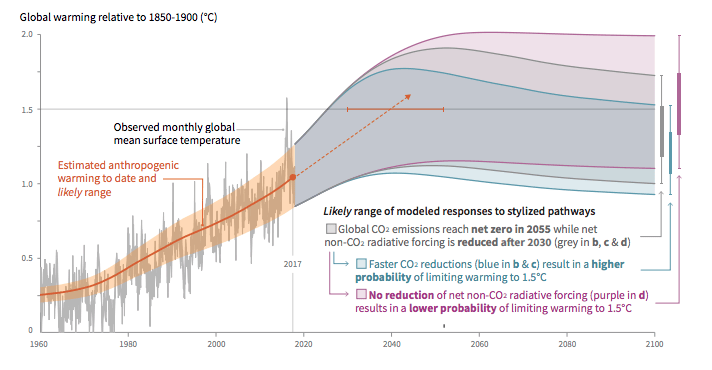A new report requested by the UN and completed by the world’s top climate scientists takes a look at the likelihood that the Paris Climate Agreement will meet its goals to limit global warming.
The picture it paints isn’t pretty.
What is this report?
Somewhat confusingly, the Paris Agreement has two separate goals relating to limiting global warming. The agreement calls on the world to limit warming to 2 degrees Celsius, but it also says it would be ideal if the world could limit warming to 1.5 degrees Celsius. Both goals are roughly seen as tipping points, past which climate change becomes much worse and locks in further changes.
Along with setting those goals, the agreement asks the Intergovernmental Panel on Climate Change to produce a report looking at the temperature goals, what it would mean to meet them, and the likelihood that we can and the pathways toward doing so. That report came out Monday.
What does it say?
The 1.5 degree goal would be vastly preferable to the 2 degree goal, sparing the Earth from dramatic climate impacts; preserving biodiversity that would disappear in a warmer, more volatile world; and saving human lives. The world has already warmed by 1 degree Celsius, the report says, and we’re likely to reach 1.5 degrees at some point in the next few decades if global warming continues to move as fast as it has been.
If the world warms from where it is today to 1.5 degrees Celsius, it will look considerably different, with higher temperatures, including extreme heat waves, over most of the world’s populated regions; stronger, wetter storms; and deeper droughts. And just as 1.5 degrees Celsius will look quite a bit different than where we are now, 2 degrees Celsius will look quite a bit worse than 1.5.
That all sounds abstract, but the examples in the report are sobering.
A world 1.5 degrees warmer would see the Arctic Ocean entirely free of sea ice — devastating Arctic ecosystems — once per century, whereas a world 2 degrees warmer would see the Arctic Ocean free of ice during the summer once every ten years. A world 1.5 degrees warmer would have several hundred million fewer people in poverty than a world 2 degrees warmer. In a world 2 degrees warmer, the world would have lost 99 percent of its coral reefs; in a world 1.5 degrees warmer, there would be more coral reefs, though there would still be 70 to 90 percent fewer than there are today.
The report also makes clear that even if humans were to stop polluting tomorrow, it would take a while for the climate to stabilize. The planet would continue to grow warmer and seas would continue to rise. If the world is to meet the 1.5 degree goal, it will have to reduce climate change-causing emissions (gases like carbon dioxide and methane) well before reaching 1.5 degrees.
In order to meet the 1.5 degree goal, humans must be ready for “rapid, far-reaching and unprecedented changes in all aspects of society,” the IPCC said in a statement. That means that by 2030 — just 12 years from now — human-caused emissions would have to decline 45 percent from where they were in 2010. By 2050, they’d have to reach net zero.
“Limiting warming to 1.5°C is possible within the laws of chemistry and physics but doing so would require unprecedented changes,” Jim Skea, co-chair of IPCC Working Group III, said in a statement.
What does it mean?
The situation is fairly dire, and the chance of humanity meeting the 1.5 degree goal is slim. Even the 2 degree target is a stretch. For 2 degrees, emissions would need to decline 20 percent by 2030 and reach net zero around 2075. “The next few years are probably the most important in our history,” Debra Roberts, co-chair of IPCC Working Group II, said.
This news comes in a world in which dealing with this collective-action problem has been shifted to the back burner even as the signs that the climate is changing — warmer weather; worse droughts; stronger, wetter storms; and powerful forest fires — are increasingly visible to those without any kind of scientific education.
Governments over which fossil fuel interests hold considerable sway are throwing a wrench in the gears of UN efforts to deal with climate change and even these IPCC reports. As Climate Home News reports, Saudi Arabia fought to, and succeeded in, cutting a passage of the summary that said fossil fuel extraction would need to fall by 60 percent by 2050. The U.S. made sure the report’s summary mentioned the potential of nuclear energy and carbon capture and storage, two technologies with significant lobbying power in Washington and which the Trump administration has touted at UN climate talks. A leading candidate in Brazil’s multi-round presidential elections, Jair Bolsonaro, promises to follow Donald Trump’s lead and pull his country out of the Paris Agreement.
The UN is hoping to shock the world into action ahead of September 2019’s gathering at the UN. That included a speech by Secretary General Antonio Guterres in September and Monday’s IPCC report, laying out the specifics behind a situation that policymakers were already largely familiar with. The global approach to this year’s climate summit in Poland, three years after the Paris Agreement was hammered out at a similar summit, will give us a sense whether diplomats have heeded the dire call for action.
